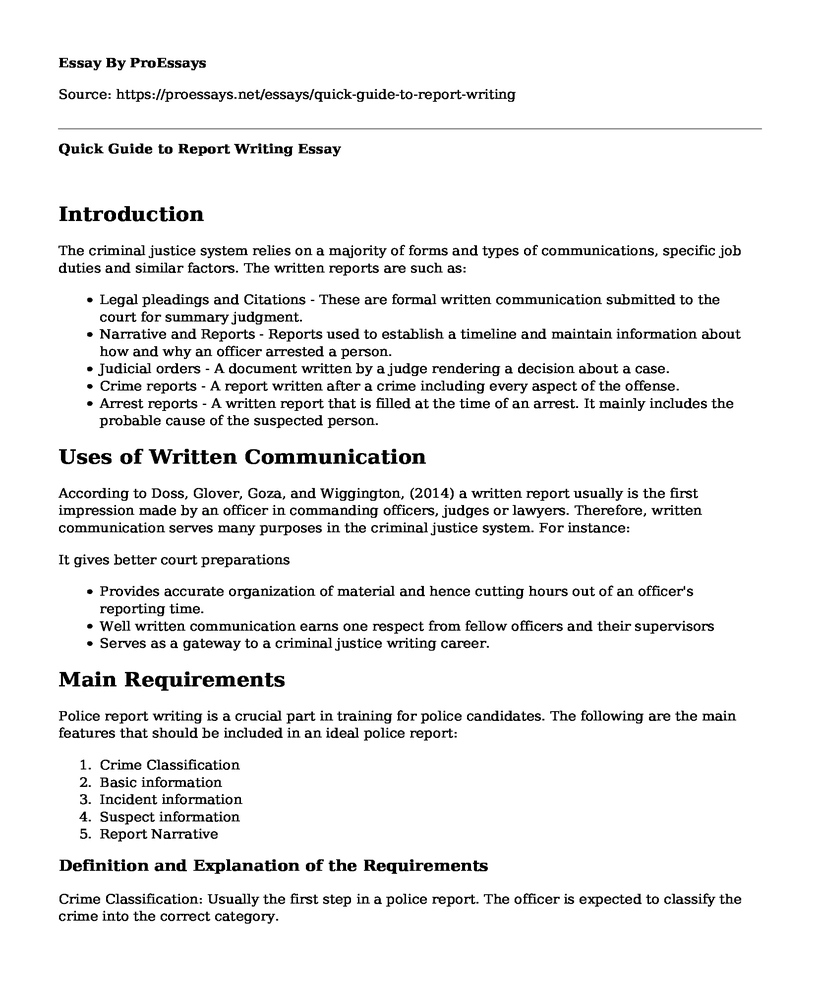Introduction
The criminal justice system relies on a majority of forms and types of communications, specific job duties and similar factors. The written reports are such as:
- Legal pleadings and Citations - These are formal written communication submitted to the court for summary judgment.
- Narrative and Reports - Reports used to establish a timeline and maintain information about how and why an officer arrested a person.
- Judicial orders - A document written by a judge rendering a decision about a case.
- Crime reports - A report written after a crime including every aspect of the offense.
- Arrest reports - A written report that is filled at the time of an arrest. It mainly includes the probable cause of the suspected person.
Uses of Written Communication
According to Doss, Glover, Goza, and Wiggington, (2014) a written report usually is the first impression made by an officer in commanding officers, judges or lawyers. Therefore, written communication serves many purposes in the criminal justice system. For instance:
It gives better court preparations
- Provides accurate organization of material and hence cutting hours out of an officer's reporting time.
- Well written communication earns one respect from fellow officers and their supervisors
- Serves as a gateway to a criminal justice writing career.
Main Requirements
Police report writing is a crucial part in training for police candidates. The following are the main features that should be included in an ideal police report:
- Crime Classification
- Basic information
- Incident information
- Suspect information
- Report Narrative
Definition and Explanation of the Requirements
Crime Classification: Usually the first step in a police report. The officer is expected to classify the crime into the correct category.
Basic Information: This is the kind of information that is filled using the victim and the suspect's identification card and includes contact information such as addresses and phone numbers.
Incident Information: This is the basic information that includes, the date of the crime, time, and even the location of the incident.
Suspect Information: In this part of the police report, the officer responsible for the crime gets meticulous descriptions of the suspect. This includes the suspect's physical details such as age, height, clothing, hair color, race, and complexion, among many others.
Report Narrative: This is the part of the report which includes a narrative or a summary of the whole crime experience. The information in this section has to be organized in chronological order.
Summary
The identified report features are essential in every report written by a police officer for the criminal justice system. In particular, the criminal justice field expects officers to have skills and to not only apprehend and prevent crime but also to report those apprehensions, appropriately. Grubb and Hemby (2018) points out that accurate reporting includes more than all the necessary facts and information. Instead, it involves the effective demonstration of cognitive and technical skills.
Besides, it is evident that the judicial process cannot operate without the investigative reports that are written by the officers who have the direct knowledge of the incident or the event that took place. This being said, unless there is sufficient cause to justify the actions done, a suspect's freedom, privileges, and rights cannot be denied or taken away from them.
In a nutshell, the reason why a useful report is essential in a criminal justice system centers on the fact that a due criminal justice process requires, officers, judges, and prosecutors to have sufficient information and evidence to initiate or continue the judicial process to exonerate of successfully prosecute any suspect.
References
Doss, D. A., Glover, W. H., Goza, R. A., & Wiggington, M. (2014). The foundations of communication in criminal justice systems (1st ed.). CRC Press.
Grubb, R., & Hemby, V. (2018). Effective Communication in Criminal Justice (1st ed.). SAGE Publications.
Cite this page
Quick Guide to Report Writing. (2022, Jun 05). Retrieved from https://proessays.net/essays/quick-guide-to-report-writing
If you are the original author of this essay and no longer wish to have it published on the ProEssays website, please click below to request its removal:
- Policing Strategies in Hot Spot Regions - Literature Review Example
- Paper Example on Human Rights and Research in Healthcare
- Research Paper on Court Cases and Ethical Behavior
- Root Causes of Crimes in Low-Income Neighborhoods - Research Paper
- Essay on Drug Arrests: Uncovering Racial Disparities and Strategies to Minimize Inequities
- 3 Million Denied Firearms: Private Sellers Exempt From Background Checks - Research Paper
- Court Participants - Free Report Example







